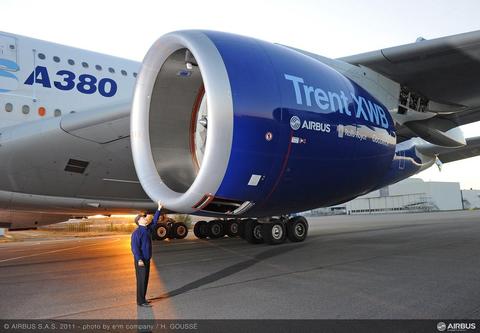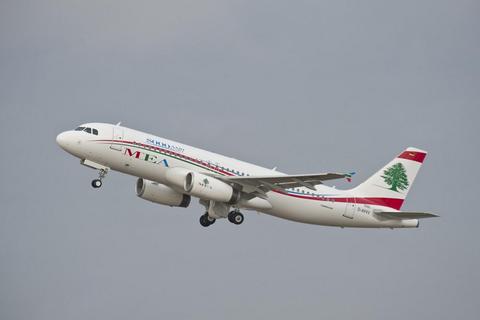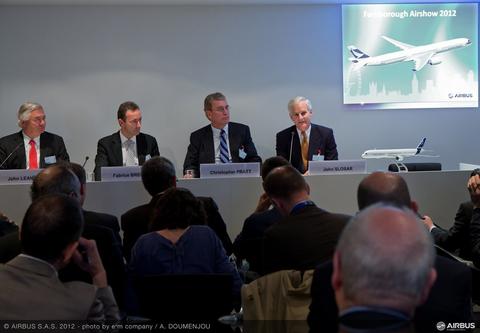With the momentum created by a “year of records” in 2011, Airbus set its sights in 2012 on goals that include further production ramp-up for the company’s jetliner families, final assembly of the initial A350 XWB aircraft, and certification of the A320 product line’s Sharklets fuel-saving wingtip devices – all of which will be supported by additional growth in its employee count.
The planned production acceleration will raise Airbus’ output for its best-selling A320 Family in 2012 to an all-time high of approximately 42 aircraft monthly, with the A380 cadence moving toward three per month, and production of the A330 rising to meet a goal of 9.5 jetliners monthly.
To meet these increased production rates – while also securing major programme milestones for the new A350, A320neo and A400M military airlifter – Airbus is keeping a focus on expanding its workforce’s size, skills and talent – adding at least 4,000 more employees in 2012, which follows the 4,500 new recruits hired the previous year.
Driven by its exceptional sales performance in 2011, Airbus entered 2012 with a backlog of 4,437 aircraft – representing a combined list price value estimated at $588 billion. This included 1,256 firm bookings for the A320neo Family by 23 customers, confirming its status as the fasting-selling jetliner ever, and bringing overall sales for the entire A320 Family to 8,292 aircraft as of 31 December 2011.

The A350 XWB takes shape
New programme milestones achieved in 2012 for Airbus’ A350 XWB have brought this next-generation wide-body jetliner closer to its maiden flight.
Airbus officially unveiled the A350 XWB’s final assembly line in Toulouse, France with a 23 October ceremony that spotlighted the first two airframes to be built: the no. 1 aircraft constructed for flight (designated MSN1 in the company’s numbering system), along with an airframe for ground-based testing.
The new purpose-built industrial site incorporates 53,000 square metres of aircraft assembly halls and 19,000 square metres of annexes – including offices, workshops and logistics areas. It was constructed near Airbus’ existing A330 production facilities to provide an optimisation of resources.
This production facility – named after Airbus visionary Roger Béteille – was built within 29 months, and is the greenest final assembly line ever constructed by Airbus. With a new lighting system, roof-mounted photovoltaic solar panels, translucent panels and glass arched roofs, it is capable of producing energy equivalent to 55% of its own needs.

A350 XWB MSN1 completed its overall structural assembly and system connections in late 2012, enabling its early December transfer from the final assembly line’s main assembly hall (Station 40) to the adjacent indoor ground test station (Station 30). Assembly work performed while the aircraft was in Station 40 included the electrical power-on of its entire fuselage and wings.
Station 30 activity will start by testing the aircraft's hydraulic system, followed by the full electric and hydraulic power-on of the aircraft, marking the start of several weeks of comprehensive functional system testing.
MSN1 is an A350-900 version – the A350 XWB Family’s intermediate-sized member.
Airbus’ second aircraft to be assembled also is sized as an A350-900, and this airframe is to be used for ground-based testing to validate the jetliner’s structural design. It was moved in November from the Roger Béteille Final Assembly Line to Airbus’ L34 static test hall – situated across the airport in the Lagardère industrial zone. This clears the way for the airframe to be integrated into a test rig for nearly a year of evaluations, including limit load and ultimate load validations, along with residual strength and margin research.
In other programme developments during 2012, the A350 XWB’s new Rolls-Royce Trent XWB engine went airborne in February, installed on the dedicated A380 flying testbed aircraft. From its first flight, this powerplant demonstrated its new-generation fuel efficiency and low noise levels.
With its start-up approximately one year prior to the A350 XWB’s planned maiden takeoff, the engine flight test evaluations are to accumulate around 175 flight hours – some three times more airborne flying hours than on previous programmes. This will be accomplished over a seven-month period, and will include hot weather as well as icing condition testing campaigns, along with validation of the advanced nacelle and thrust reverser system.

The 5,000th A320 delivery... and more A320 orders
Not surprisingly, many of Airbus’ programme and commercial milestones in 2012 were related to the A320 Family, including delivery of the 5,000th aircraft to Middle East Airlines of Lebanon in January, as well as two historic bookings in December: an order for 100 additional A320 jetliners by AirAsia, and Pegasus Airlines’ signing for up to 100 A320neo Family aircraft. As of December 18, the A320 Family logged 8,800 aircraft ordered and 5,300 jetliners delivered to over 380 customers and operators across the globe, making the A320 Family the world’s best-selling single-aisle aircraft family.
Key bookings during the first six months included an acquisition of 100 A320neo jetliners by Norwegian – one of the largest low-cost airlines in Europe – positioning this carrier as a new customer for Airbus. Additionally, AviancaTaca firmed up an order for 51 A320s, making it the largest purchase agreement for a single customer in Latin America history.
The second half of 2012 also was highly successful thanks in part to AirAsia’s new order in December for an additional 64 A320neo and 36 A320ceo aircraft, reaffirming the airline’s position as the world’s largest A320 Family customer. The company’s current all-A320 fleet services some 70 destinations in 20 countries across Asia.
Later in December, Turkey’s Pegasus Airlines – the country’s second-largest carrier – became a new Airbus customer when it signed for as many as 100 A320neo Family aircraft (57 A320neo and 18 A321neo), of which 75 were firm orders. It marks the largest single commercial aircraft order ever placed by a Turkish carrier. Pegasus will use the jetliners to service the company’s rapidly-expanding network from Istanbul to destinations in Turkey, Europe and the Middle East.
In the U.S., the A320neo’s acceptance in the market was underscored in 2012 with Spirit Airlines’ firming up of a 45-aircraft booking, along with an order for 30 A320s. These new aircraft will be used on Spirit’s growing network of flights in the domestic United States, Caribbean and Latin America, and will join the A320 Family aircraft successfully operated by the airline for the past seven years.

Fuel-saving A320 Family “Sharklets”
Airbus’ application of its fuel-saving and performance-enhancing Sharklet large wingtip devices on the A318, A319, A320 and A321 jetliners marked numerous milestones in 2012, culminating in December with AirAsia becoming the first carrier to receive a Sharklets-equipped jetliner.
Achievements included a roll-out of the initial new-build A320 fitted with Sharklets in April as one of eight aircraft being used in the test campaign for these devices in their production-standard version.
It was accompanied in October 2012 by the initial Sharklets-equipped A321, and was joined one month later by the no. 1 A319 with these devices.
The Sharklets – which decrease aerodynamic drag by helping reduce the spiral-shaped vortices formed at aircraft wingtips during flight – are offered as an option on members of the in-production A320ceo (current engine option) A320 Family, and will be standard on Airbus’ A320neo (new engine option) jetliners.
In December, Airbus announced certification of the first jetliner/engine combination with Sharklets approved by the European Aviation Safety Agency (EASA) airworthiness authority: the A320 powered by CFM International’s CFM56 powerplant.
It was this A320 version that AirAsia, a major low-cost carrier and the largest A320 Family airline customer, received later in the same month – positioning it to become the world’s first operator of a jetliner with Sharklets.

90-plus A380s delivered
The popularity of Airbus’ 21st century flagship aircraft – the A380 – continued to spread in 2012.
A new programme milestone was reached in May with delivery of Malaysia Airlines’ initial aircraft – making it the eighth carrier worldwide to receive an A380. This 75th delivery overall was the first of six that Malaysia Airlines has on order, and it is to be used for operations on the Kuala Lumpur-London route. Delivered at Airbus’ Toulouse headquarters location, it incorporates a new livery including a modern interpretation of the Malaysian “wau” moon-kite national symbol, as well as an updated logo for the carrier.
In June, Transaero Airlines became Airbus’ first customer for the A380 in Russia, the Commonwealth of Independent States and Eastern Europe when it completed a purchase agreement for four aircraft. These jetliners will seat approximately 700 people in a three-class cabin layout and are expected to be used on the airline’s higher density routes from Moscow.
Thai Airways International (THAI) became the ninth carrier worldwide to add Airbus’ A380 to its fleet with the September handover of the airline’s no. 1 aircraft – named Si Rattena, or “Majestic Jewel” – at a special ceremony in Toulouse, France.
THAI has ordered six aircraft in total, with each to accommodate 507 passengers in a premium three-class layout with a new cabin design. First class is equipped with 12 private suites while the Royal Silk Class contains 60 fully flat sleeper seats. All seats are equipped with the latest on-demand in-flight entertainment systems, communications outlets and individual power supplies.
This jetliner – which is powered by Rolls-Royce Trent 900 engines – began operations on the company’s Bangkok-Hong Kong and Bangkok-Singapore routes when it entered service. THAI is expected to begin service using A380s to Frankfurt at the end of the year, as well as to Tokyo and Paris in early 2013 as more aircraft are delivered.
From the A380’s October 2007 introduction through September 2012, more than 650,000 total revenue flight hours were logged by the jetliners during operations worldwide – representing a combined cumulative time aloft of nearly 75 years. The A380 fleet was performing one departure or landing every seven minutes, with an average daily utilisation of 13.4 hrs. per aircraft.
As of end-November 2012, Airbus had delivered more than 90 A380s to the nine airlines: Air France, China Southern, Emirates, Korean Air, Lufthansa, Malaysia Airlines, Qantas, Singapore Airlines and THAI.

Giving mature A330 jetliners a new career
The A330 Passenger-to-Freighter (P2F) conversion programme was given its start in 2012 through an agreement involving EADS EFW (a sister company in the EADS group) and Singapore’s ST Aerospace.
The A330P2F programme offers a passenger-to-freighter conversion opportunity for A330s that have completed their useful operational service as passenger jetliners.
Both the A330-200 and A330-300 versions are eligible for the P2F conversion. With its longer fuselage, the A330-300P2F is particularly suited for integrators and express carriers, resulting from its high volumetric payload capability with lower-density cargo, while the A330-200P2F is optimised for higher-density freight and longer-range performance.
The A330 offers a highly capable platform for conversion into a freighter, with modern Airbus technologies that include fly-by-wire flight controls. Overall, more than 1,180 A330s have been ordered in the passenger, freighter, VIP, and military aerial tanker/transport versions, with over 800 delivered from the A330’s service entry in 1994 through early 2012 – providing a large source of aircraft to support these conversions for many years.
A330P2F aircraft will be complementary to Airbus’ new-production A330-200F freighters, as the converted jetliners address a different price-point and end-users, based on separate operational requirements.

Fabrice Brégier named President and CEO
Airbus marked a key management change on 1 June as Fabrice Brégier became the company’s President and Chief Executive Officer.
Brégier had served as Airbus Chief Operating Officer since 2006, and succeeds Tom Enders, who takes the duties as CEO of parent company EADS.
During his previous COO role, Brégier worked on the implementation of Airbus’ company-wide restructuring and change program, while also overseeing Executive Committee actions involving operations, engineering and procurement.
With Brégier now “at the controls,” the focus will be on increasing Airbus’ global footprint while also ramping-up production.
Succeeding Brégier as the Airbus COO is Guenter Butschek, who is now in charge of operations, engineering, procurement, quality and lean, information technology and communications technology.

Focus on eco-efficiency: an A319 “perfect flight”
Airbus and Air Canada joined to perform North America’s first-ever commercial “Perfect Flight” on 18 June, using one of the airline’s A319s flown from Toronto to Mexico City with the goal of cutting CO2 emissions by more than 40% compared to a regular trip.
This “Perfect Flight” combined the Airbus A320 Family’s capabilities as a modern state-of-the-art airliner series, powered by a sustainable alternative 50 per cent sustainable aviation fuel blend made with used cooking oil, and employing streamlined air traffic management procedures – all facilitated through best practice operations to underpin the airline industry’s strategy to tackle carbon emissions.
The cross-border activity follows the first “Perfect Flight” achieved in November 2011, which used an Air France A321 flying on a domestic French segment from Toulouse to Paris.

Expanding production and the global footprint
Airbus announced on 2 July that it will establish the company’s first U.S.-based production facility in Mobile, Alabama.
This new A320 Family final assembly line – which is part of a strategy to enhance the company’s global competitiveness as well as bring it closer to North American customers – will produce the single-aisle A319, A320 and A321 and is expected to start operation in 2015, with first deliveries beginning in 2016.
The strategy expands and enhances Airbus’ U.S. presence, while adding another company facility in the state of Alabama, which currently is home to an engineering centre at the Mobile Aeroplex at Brookley, as well as an Airbus Military customer service operation that also is located in Mobile.
Airbus’ new A320 Family final assembly line will involve an estimated investment of approximately $600 million, and is to consist of 53 acres of buildings, aprons and roadways contained within a 116 acre site.

Customers confirm Airbus’ product line strategy
The 2012 Farnborough Airshow brought new airline industry backing for Airbus’ commercial and industrial strategies, with additional single-aisle and wide-body jetliner orders announced and endorsements received for two of its enhanced aircraft.
During the week-long international event, Airbus announced the launch of an increased maximum takeoff weight for its twin-engine A330, further enhancing the operating range and payload capability of this long-popular jetliner. This takeoff weight boost to 240 metric tonnes includes the integration of aerodynamic technologies from the A350 XWB programme, along with enhancements to the aircraft’s jet engines.
CIT Group Inc. placed the first order for this increased takeoff weight A330 version two days after the launch announcement was made, adding to the transportation finance company’s already large portfolio of the jetliners available for lessors.
In November, Airbus announced a further improvement of the A330 takeoff weight, with an increase to 242 metric tonnes for both the A330-200 and A330-300 versions. This upgrade also provides an increased fuel capacity option for the larger A330-300, and builds on the enhancements announced during the Farnborough Airshow.
Another key development at the biennial Farnborough event was Cathay Pacific’s choice to incorporate 26 A350-1000s into its fleet, validating Airbus’ action in 2011 to improve the A350-1000 version of its A350 XWB wide-body jetliner family with a higher-thrust engine and an increased takeoff weight.
Overall, Airbus announced 115 new sales and commitments during the Farnborough Airshow, which also included 57 commitments for the A320ceo (current engine option) family – demonstrating this is still the industry’s benchmark single-aisle aircraft product line, along with 29 bookings for the A320neo (new engine option).

Tianjin assembly line completes 100th A320 Family aircraft
The Airbus A320 Final Assembly Line China (FALC) achieved a production milestone in August with completion of the 100th single-aisle aircraft built at the Tianjin facility. German Chancellor Angela Merkel and Chinese Premier Wen Jiabao presided over a celebration of this accomplishment, which was attended by some 1,000 people.
One day prior to the event, a framework agreement was signed by Airbus, the Tianjin Free Trade Zone and the Aviation Industry Corporation of China to continue cooperation on this joint-venture assembly line beyond the current business plan – which is due to expire in 2016.
Opened in August 2008, the Tianjin site is the third A320 Family final assembly line worldwide, and is Airbus’ first outside of Europe.
Aircraft delivered from the complex have been received by 11 Chinese operators, while more than 500 A320 Family jetliners have been ordered in China since the Tianjin project’s original agreement was signed.
The milestone 100th Chinese-built Airbus jetliner was delivered to Air China in September, with this A320 planned for operation on domestic routes linking Shanghai to other cities in the country.





